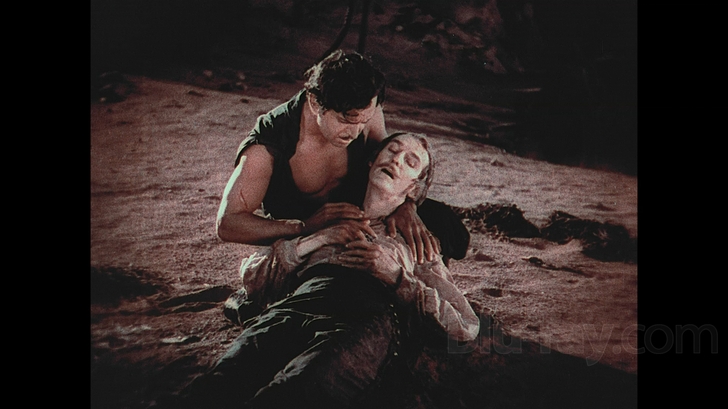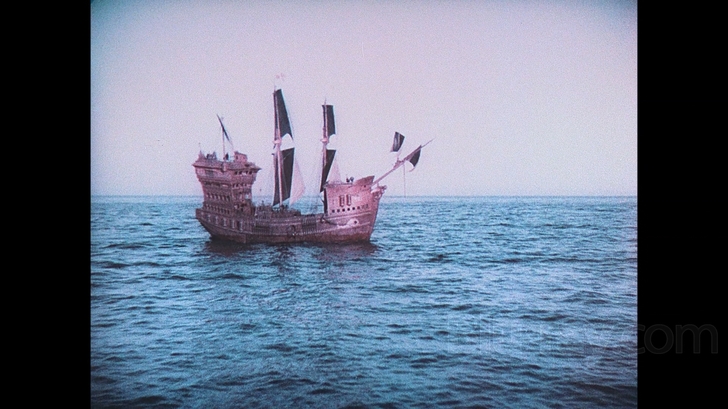The Black Pirate Blu-ray Movie
HomeThe Black Pirate Blu-ray Movie 
Kino Lorber | 1926 | 94 min | Not rated | Dec 14, 2010
Movie rating
7.1 | / 10 |
Blu-ray rating
| Users | 0.0 | |
| Reviewer | 4.0 | |
| Overall | 4.0 |
Overview
The Black Pirate (1926)
Douglas Fairbanks is a simple shipwrecked man who vows revenge on the pirates who caused the death of his father. Through a bold attack he gains their ship and becomes their trusted captain. Adventure and intrigue abound in this early example of Technicolor.
Starring: Billie Dove, Tempe Pigott, Donald Crisp, Sam De Grasse, Anders RandolfDirector: Albert Parker
| Adventure | Uncertain |
| Action | Uncertain |
Specifications
Video
Video codec: MPEG-4 AVC
Video resolution: 1080p
Aspect ratio: 1.34:1
Original aspect ratio: 1.33:1
Audio
English: LPCM 2.0
English: Dolby Digital 2.0
Subtitles
None
Discs
50GB Blu-ray Disc
Single disc (1 BD)
Playback
Region free
Review
Rating summary
| Movie | 4.0 | |
| Video | 4.5 | |
| Audio | 4.0 | |
| Extras | 2.5 | |
| Overall | 4.0 |
The Black Pirate Blu-ray Movie Review
Avast! Primitive Technicolor!
Reviewed by Casey Broadwater December 12, 2010Between Errol Flynn and Douglas Fairbanks, I’m not even going to get into who was the better swordsman, but let’s just say that if Flynn was the father of the modern swashbuckling genre, Fairbanks was its granddaddy, supplying all of the necessary cinematic DNA. After playing primarily comic characters between 1915 and 1919, Fairbanks rose to action hero superstardom with the 1920 release of The Mark of Zorro. The swordplay and derring-do continued in a string of lavish costume adventures that Fairbanks wrote, produced, and starred in—like Buster Keaton, he was a triple threat—including 1921’s The Three Musketeers, 1922’s Robin Hood, and 1924’s The Thief of Bagdad. In 1926, he would stage his biggest spectacle yet, The Black Pirate, a high seas escapade with all the action and capital-R-Romance audiences expected from a Fairbanks picture. What set this one apart, however, and what makes this an important Blu-ray release for silent film enthusiasts, is that The Black Pirate was shot in color.

Douglas Fairbanks
Specifically, it was shot in Process 2 Technicolor, often called “two-strip” or “two-color,” a system invented in 1922 that involved using a proprietary Technicolor camera to simultaneously expose two frames of black and white film behind red and green filters, respectively. In the lab, these frames were printed on separate strips, dyed the opposite color of the filter they were behind in the camera, and then glued together to create a projection print. The spectrum is less sophisticated (and realistic) than the full-color, three-strip Technicolor system that would be introduced in 1932, but the limited palette of Process 2—with its rusty reds and muted greens—has a charm all its own, a faded storybook quality that’s perfect for this kind of antiquated tale. And Fairbanks made great use of it. He’d held off on making his grand pirate movie until he could shoot it in color, and once the technology was in place, he was determined to do it right. Ever the perfectionist, the filmmaker spent considerable time in pre-production testing the limits of the two-tone process, carefully considering the colors of the costumes and sets so that they would be pleasing and unobtrusive on screen, and not overly garish or unnatural. The result is one of the most stunning—and complete—examples of early color cinematography. Precious few of the color features from the silent era have survived, which makes The Black Pirate a true gem.
The story itself is a fairly typical pirate yarn, and the first intertitle explains exactly what’s in store for the audience: “an account of buccaneers & the Spanish Main, the Jolly Roger, golden galleons, bleached skulls, buried treasure, the Plank, dirks & cutlasses, scuttled ships, marooning, desperate deeds, desperate men and—even on this dark soil—romance.”
We’re introduced to a rowdy lot of pirates—led by a vicious bald-headed captain (Anders Randolf)—whose preferred tactic is to “subdue their prey, bind their captives, steal their loot, and blow them up!” And we see them do just that to the defenseless crew and passengers of a captured ship. The sole survivors, an old man and his son (Fairbanks), wash up on the shore of the island where the pirates have gone to stash their stolen booty. The father dies, and the son makes a vow of revenge “to bring thy murderers to justice.”
He swaggers fearlessly into the pirate encampment and announces that he’d like to join their company—in a bid, of course, to bring them down from the inside. Naturally, to enter this band of thieves and cutthroats, he has to prove himself, which he does by defeating the pirate captain in a rousing swordfight and single-handedly—without violence—commandeering a passing merchant ship. For this, he comes to be known as “the Black Pirate,” and the now-captainless scallywags move to put him in charge. To save the hijacked ship’s crew from being blown to smithereens, he comes up with a plan to hold the vessel ransom—he’s biding his time—and when a terrified princess (Billie Dove) is found in one of the staterooms, the Black Pirate must think quickly to save her virtue from the lecherous pirate hordes. None of this sits well with the previous second-in-command (Sam de Grasse), a jealous and sullen villain who wants to take the role of captain—and the princess—for his own. Much swashbuckling ensues.
New York Times film critic Mordaunt Hall—what a name—was right when he claimed, in his 1926 review, that The Black Pirate is “a series of robust scenes slung on a slender thread of a story.” As slight as the plot is—and as one-note as the characters are—the film is an enjoyable adventure, buoyed by the screen charisma and athletic prowess of its star. While perhaps lighter on stunts than some of Fairbanks’ earlier pictures, The Black Pirate has several memorable—and innovative—action sequences. One oft-imitated stunt has Fairbanks leaping off the mast, sticking his sword into the sail, and ripping his way down, essentially using the tearing cloth to slow his descent. (This scene was even the subject of a pirate-centric episode of Mythbusters.) He swings from ropes, leaps between decks, and once even clutches the corner of a wind-filled sail, cuts the rope holding it in place, and uses the kinetic energy to launch him up into the rigging. (Never mind that this was actually filmed in reverse— with Fairbanks starting up on the mast and swinging down to the deck—it’s still impressive.) The most visually spectacular scene shows a score of buccaneers swimming underwater in an Esther Williams-esque formation. It’s oddly haunting—given the murky Technicolor toning—and it’s hard to tell exactly how it was filmed. This is part of the fun for modern audiences—trying to guess how the filmmakers achieved certain shots—not just in The Black Pirate, but in watching all silent films. For these cinematic pioneers, innovation was a necessity. And with The Black Pirate, Fairbanks created a template for all pirate films to follow. That he did so in color—in 1926—adds even more to the film’s cultural and historical worth.
The Black Pirate Blu-ray Movie, Video Quality 

Silent film followers, you're in for a Technicolor treat. Kino's restoration—and this Blu-ray's 1080p/AVC-encoded transfer—is a wonder to behold. There's something completely surreal about watching color footage from 1926. We're so used to imagining this time period in black and white—as if people back then actually walked around in monochrome—that, for the first few minutes, seeing The Black Pirate's two-tone color palette is actually jarring. In a good way. I simply love the look of this film. The subtractive Process 2 Technicolor system provides, in my opinion, a much more pleasing aesthetic than hand-tinting. The process was most adept at reproducing red/orange and blue/green tones, so you'll notice that the image often has the look of a sepia print that's been imbued with muted color. Here, there are a few scenes when the tones fluctuates or even fade almost entirely to black and white, but most of the time the colors are pleasingly—though not overly—dense. I can only speculate as to how much digital restoration was required on Kino's part, but they certainly stayed true to the "two-strip" look. The print itself is in fairly good condition. There are the expected flecks, some staining, and mild brightness flickering, but no major warping, tears, or other heavy damage. The degree of clarity in the image is often striking, especially in the velvety texture of the Princess' dress and the detail in rocks and sand on the beach. As hoped for, the grain structure is fully intact, and there's no evidence of edge enhancement or encode issues like banding, macroblocking, or compression noise. For some reason—and I'm sure Kino had their reasons—the intertitles appear slightly windowboxed inside a deep maroon frame, but this is a non-issue. As the earliest color feature film to appear on Blu-ray, The Black Pirate looks fantastic.
The Black Pirate Blu-ray Movie, Audio Quality 

Kino has provided two audio options here. The default, a Linear PCM 2.0 mix, is an orchestral performance of the original 1926 Mortimer Wilson score, conducted by Robert Israel in 1996. The music sounds exactly as it ought to—clear, dynamically solid, and unobtrusive. That is, it complements the onscreen action rather than overshadowing it. The second offering is a Dolby Digital 2.0 organ score by Lee Erwin, which is lossy, yes, but sounds perfectly acceptable. I prefer the default track, but both suit the film well. No problems here.
The Black Pirate Blu-ray Movie, Special Features and Extras 

- Commentary by Film Historian Rudy Behlmer: Behlmer delivers a track that tells you just about everything you'd ever need or want to know about the production of The Black Pirate. Essential listening.
- The Black Pirate "Talkie" (1080p, 1:15:12): Douglas Fairbanks Jr. commissioned a "talkie" version of The Black Pirate in order to introduce his father to a new generation of fans. Here, the intertitles are removed, replaced by a soundtrack with narration and occasional effects. Note that this version of the film is presented in black and white, not color.
- Narrated Outtakes (1080i, 18:06): Behlmer guides us through a series of outtakes from the film, including deleted sequences and unused or botched takes from sword fights and action scenes.
- Other Outtakes (1080i, 29:05): Additional outtake material, presented without audio.
- Stills (1080p): A user-controlled gallery with 31 stills.
The Black Pirate Blu-ray Movie, Overall Score and Recommendation 

This release of The Black Pirate is noteworthy specifically because it's now the oldest color film to be released on Blu-ray, not to mention one of the few color features from the silent era that has survived into the 21st century. The film itself is conventional pirate fare, but it does offer several sequences that are both thrilling and impressive from a filmmaking perspective. As expected, Kino has put together a fine release, with a beautifully restored picture, uncompressed audio, and a small but meaty array of supplements. Recommended!
Similar titles
Similar titles you might also like

The Sea Hawk
Warner Archive Collection
1940

The Count of Monte Cristo
2002

Cutthroat Island
1995

Against All Flags
1952

Reap the Wild Wind
1942

The Black Swan
Fox Studio Classics
1942

The Three Musketeers
1921

The Man in the Iron Mask
1977

The Long Ships
1964

Jamaica Inn
75th Anniversary Edition
1939

Blood Alley
Warner Archive Collection
1955

Robin Hood
1922

Four Frightened People
1934

The Hurricane
1937

King Solomon's Mines
2004

20,000 Leagues Under the Sea
1916

Prince of Persia: The Sands of Time
2010

Sword of the Valiant: The Legend of Sir Gawain and the Green Knight
1984

Bird of Paradise
1932

The Adventures of Hajji Baba
Limited Edition to 3000
1954
